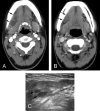OK-432 sclerotherapy of plunging ranula in 21 patients: it can be a substitute for surgery
- PMID: 16687549
- PMCID: PMC7975734
OK-432 sclerotherapy of plunging ranula in 21 patients: it can be a substitute for surgery
Abstract
Background and purpose: Although first-choice therapy for the ranula is surgery, this choice presents technical difficulties and frequent recurrences because of insufficient surgery. We evaluated the efficacy of OK-432 sclerosis of the plunging ranula as a substitute for surgery.
Methods: Twenty-one patients with plunging ranula were treated with intralesional injection of OK-432. The liquid content of the ranula was aspirated as much as possible, after which OK-432 solution was injected in the same volumes as that drawn out. Patients were followed on sonography or CT.
Results: Seven (33.3%) patients with plunging ranulas showed total shrinkage and resolution, and 4 (19%) patients showed near-total shrinkage (more than 90% of the volume). Four (19%) patients revealed marked shrinkage (more than 70% of the volume), and 3 (14.3%) patients showed partial shrinkage (less than 70% of the volume). Three (14.3%) patients showed recurrence after total shrinkage 1 month after injection. The overall recurrence rate after each injection was 47% (16 of 34 injections in 21 patients), but the recurrence rate after the last sclerotherapy was only 14%. There were no serious side effects except for fever lasting 2-3 days (12 patients) and swelling (10 patients) for 3-5 days. Mild odynophagia for 1-2 days was also noted in 7 patients, and there was 1 severe case of odynophagia.
Conclusion: OK-432 sclerotherapy of plunging ranula is a safe and potentially curative procedure that may be used as a primary treatment for plunging ranula before considering surgery.
Figures





References
-
- Parekh D, Stewart M, Joseph C, Lawson HH. Plunging ranula: a report of 3 cases and a review of the literature. Br J Surg 1987;74:307–09 - PubMed
-
- Mizuno A, Yamaguchi K. The plunging ranula. Int J Oral Maxillofac Surg 1993;22:113–15 - PubMed
-
- Yoshimura Y, Obara S, Kondoh T, et al. A comparison of three methods used for treatment of the ranula. J Oral Maxillofac Surg 1995;53:280–82 - PubMed
-
- Ichimura K, Ohta Y, Tayama N. Surgical management of the plunging ranula: a review of seven cases. J Laryngol Otol 1996;110:554–56 - PubMed
-
- Davison MJ, Morton RP, Mclvor NP. Plunging ranula: clinical observations. Head Neck 1998;20:63–68 - PubMed
MeSH terms
Substances
LinkOut - more resources
Full Text Sources
